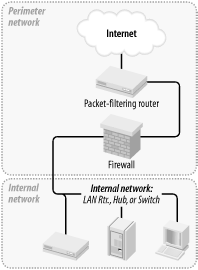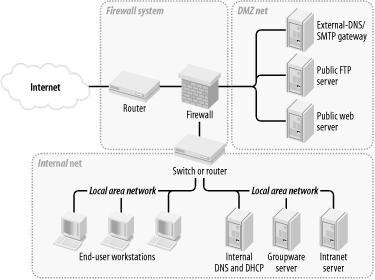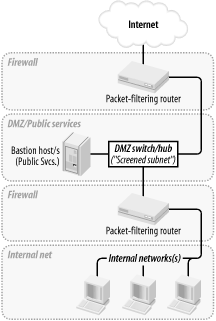Section 2.2. Types of Firewall and DMZ Architectures
In the world of expensive commercial firewalls (the world in which I earn my living), the term "firewall" nearly always denotes a single computer or dedicated hardware device with multiple network interfaces. This definition can apply not only to expensive rack-mounted behemoths, but also to much lower-end solutions: network interface cards are cheap, as are PCs in general.
This is different from the old days, when a single computer typically couldn't keep up with the processor overhead required to inspect all ingoing and outgoing packets for a large network. In other words, routers, not computers, used to be one's first line of defense against network attacks.
Such is no longer the case. Even organizations with high capacity Internet connections typically use a multihomed firewall (whether commercial or open source-based) as the primary tool for securing their networks. This is possible, thanks to Moore's law, which has provided us with inexpensive CPU power at a faster pace than the market has provided us with inexpensive Internet bandwidth. It's now feasible for even a relatively slow PC to perform sophisticated checks on a full T1's-worth (1.544 Mbps) of network traffic.
2.2.1 The "Inside Versus Outside" Architecture
The most common firewall architecture one tends to see nowadays is the one illustrated in Figure 2-1. In this diagram, we have a packet-filtering router that acts as the initial, but not sole, line of defense. Directly behind this router is a "proper" firewall ? in this case a Sun SparcStation running, say, Red Hat Linux with iptables. There is no direct connection from the Internet or the "external" router to the internal network: all traffic to or from it must pass through the firewall.
Figure 2-1. Simple firewall architecture

In my opinion, all external routers should use some level of packet-filtering, a.k.a. "Access Control Lists" in the Cisco lexicon. Even when the next hop inwards from such a router is a sophisticated firewall, it never hurts to have redundant enforcement points. In fact, when several Check Point vulnerabilities were demonstrated at a recent Black Hat Briefings conference, no less than a Check Point spokesperson mentioned that it's foolish to rely solely on one's firewall, and he was right! At the very least, your Internet-connected routers should drop packets with non-Internet-routable source or destination IP addresses, as specified in RFC 1918 (ftp://ftp.isi.edu/in-notes/rfc1918.txt), since such packets may safely be assumed to be "spoofed" (forged).
What's missing or wrong about Figure 2-1? (I said this architecture is common, not perfect!) Public services such as SMTP (email), Domain Name Service ( DNS), and HTTP (WWW) must either be sent through the firewall to internal servers or hosted on the firewall itself. Passing such traffic doesn't directly expose other internal hosts to attack, but it does magnify the consequences of an internal server being compromised.
While hosting public services on the firewall isn't necessarily a bad idea on the face of it (what could be a more secure server platform than a firewall?), the performance issue should be obvious: the firewall should be allowed to use all its available resources for inspecting and moving packets.
Furthermore, even a painstakingly well-configured and patched application can have unpublished vulnerabilities (all vulnerabilities start out unpublished!). The ramifications of such an application being compromised on a firewall are frightening. Performance and security, therefore, are impacted when you run any service on a firewall.
Where, then, to put public services so that they don't directly or indirectly expose the internal network and don't hinder the firewall's security or performance? In a DMZ (DeMilitarized Zone) network!
2.2.2 The "Three-Homed Firewall" DMZ Architecture
At its simplest, a DMZ is any network reachable by the public but isolated from one's internal network. Ideally, however, a DMZ is also protected by the firewall. Figure 2-2 shows my preferred Firewall/DMZ architecture.
Figure 2-2. Single-firewall DM2 architecture

In Figure 2-2, we have a three-homed host as our firewall. Hosts providing publicly accessible services are in their own network with a dedicated connection to the firewall, and the rest of the corporate network face a different firewall interface. If configured properly, the firewall uses different rules in evaluating traffic:
From the Internet to the DMZ
From the DMZ to the Internet
From the Internet to the Internal Network
From the Internal Network to the Internet
From the DMZ to the Internal Network
From the Internal Network to the DMZ
This may sound like more administrative overhead than that associated with internally hosted or firewall-hosted services, but it's potentially much simpler since the DMZ can be treated as a single logical entity. In the case of internally hosted services, each host must be considered individually (unless all the services are located on a single IP network whose address is distinguishable from other parts of the internal network).
2.2.3 A Weak Screened-Subnet Architecture
Other architectures are sometimes used, and Figure 2-3 illustrates one of them. This version of the screened-subnet architecture made a lot of sense back when routers were better at coping with high-bandwidth data streams than multihomed hosts were. However, current best practice is not to rely exclusively on routers in one's firewall architecture.
Figure 2-3. "Screened subnet" DM2 architecture

2.2.4 A Strong Screened-Subnet Architecture
The architecture in Figure 2-4 is therefore better: both the DMZ and the internal networks are protected by full-featured firewalls that are almost certainly more sophisticated than routers.
The weaker screened-subnet design in Figure 2-3 is still used by some sites, but in my opinion, it places too much trust in routers. This is problematic for several reasons.
First, routers are often under the control of a different person than the firewall is, and this person many insist that the router have a weak administrative password, weak access-control lists, or even an attached modem so that the router's vendor can maintain it! Second, routers are considerably more hackable than well-configured computers (for example, by default, they nearly always support remote administration via Telnet, a highly insecure service).
Finally, packet-filtering alone is a crude and incomplete means of regulating network traffic. Simple packet-filtering seldom suffices when the stakes are high, unless performed by a well-configured firewall with additional features and comprehensive logging.
Figure 2-4. Better screened subnet architecture (fully firewalled variant)

This architecture is useful in scenarios in which very high volumes of traffic must be supported, as it addresses a significant drawback of the three-homed firewall architecture in Figure 2-2: if one firewall handles all traffic between three networks, then a large volume of traffic between any two of those networks will negatively impact the third network's ability to reach either. A screened-subnet architecture distributes network load better.
It also lends itself well to heterogeneous firewall environments. For example, a packet-filtering firewall with high network throughput might be used as the "external" firewall; an Application Gateway (proxying) firewall, arguably more secure but probably slower, might then be used as the "internal" firewall. In this way, public web servers in the DMZ would be optimally available to the outside world, and private systems on the inside would be most effectively isolated.






